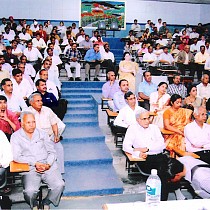SIGNIFICANCE OF IRRIGATION INTERVALS AND NITROGEN LEVELS IN MANAGEMENT OF CHILLI THRIPS, SCIRTOTHIRPS DORSALIS HOOD
Biological Control Research Laboratory, Anand Agricultural University, Anand – 388 110 (Gujarat)
B.H. PATEL, D. J. KOSHIYA, D.M. KORAT AND P.R. VAISHNAV
In order to assess the impact of irrigation intervals (10, 15, 20 and 25 days) and levels of nitrogen (100, 125 and 150 kg/ha) on the incidence of chilli thrips, Scirtothrips dorsalis Hood. (Thripidae: Thysanoptera), a field experiment was conducted at Main Vegetable Research Station, Anand Agricultural University, Anand during kharif 2002-03 and 2003-04. The numbers of thrips increased with the increase in irrigation interval. Significantly highest (3.79 thrips/leaf) population of S. dorsalis was recorded when irrigation was given at 25 days interval, whereas lowest (2.51 thrips/leaf) population was recorded when irrigation was given at 10 days interval. Similarly, significantly lowest (2.82 thrips/leaf) population of chilli thrips was recorded in the treatments with minimum (100 kg/ha) dose of nitrogen. Population of thrips increased with the increase in doses of nitrogenous. chemical fertilizers. The interaction effect between irrigation intervals and nitrogen levels on the population of S. dorsalis was significant. Decrease in irrigation interval exhibited increase in yield of green chilli. Significantly highest yield (88.21 q/ha) was harvested from the plots where irrigation was provided at 10 days interval. Irrigation provided at longer intervals (25 days) registered significantly lowest (28.08 q/ha) yield of green chilli. It was evident that delay in irrigation and increase in nitrogenous doses enhanced the build up of population of thrips on chilli.


